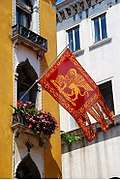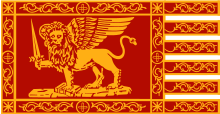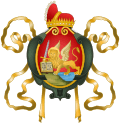Flag of the Republic of Venice
The Flag of the Republic of Venice, commonly known as the Banner or Standard of Saint Mark (stendardo di San Marco), was the symbol of the Republic of Venice, until its dissolution in 1797.
 | |
| Names | Banner of St. Mark, Standard of St. Mark, Stendardo di San Marco |
|---|---|
| Adopted | 14th Century |
| Design | A gold Lion of St. Mark on a field of dark red accompanied by six sestiere on the fly |
Its main charge was the Lion of Saint Mark, symbolizing Mark the Evangelist, the patron saint of Venice.[1] A distinguishing feature of the flag is its six fringes, which were added to represent the original six sestiere of Venice. The fringes also serve to prevent damage being caused to the central section of the flag by wind.[2]
During times of peace, the Lion of Saint Mark was depicted alongside an open Bible. However, when the Republic was at war the Bible was replaced with the lion grasping an upright sword.[1]
The flag inspired the modern Flag of Veneto region in Italy.[3]
History
It is unclear as to when the Republic officially adopted the flag. One chronicler, John the Deacon, described how in 998 Doge Pietro Orseolo II was presented with a "triumphale vexillum" (triumphal banner) before leading a naval expedition against the Narentines, pirates who moored off the eastern coast of the Adriatic and harassed Venetian seamen.[4][5] However, this chronicle does not explicitly mention the use of the Lion of St. Mark within the flag or mention the colours used upon the banner.
The first definitive recording of the usage of the Lion of Saint Mark on a red field dates back to the late thirteenth century.[6] Genoese archivist Jacopo da Varazze explicitly makes reference to the Lion of St. Mark as the official symbol for Venice. He also mentions the how phrase "PAX TIBI MARCE EVANGELISTA MEUS" was found on the flag.[4]
The winged lion was chosen as a symbol of Venice due to its connotations with Saint Mark. Venetian tradition states how Saint Mark was travelling from Aquileia to Rome when an Angel appeared whilst he was in the lagoon of Venice and stated 'Pax tibi, Marce, evangelista meus. Hic requiescet corpus tuum' (Peace be with thee, O Mark, my evangelist. Here thy body will rest).[7] The legend was used in 828 by Venetian merchants Rustico da Torcello and Bon da Malamocco to justify their journey to Alexandria to return the corpse of Saint Mark to Venice and inter it within the city. From that moment Saint Mark became the patron saint of Venice and thus began the association between the city and the winged lion.[7]
Vexillologist Whitney Smith suggests that the colours chosen, red and gold, were selected on the basis that they were the colours of the Byzantine Empire, the previous rulers of the region.[6]
For 337 years 12 Gonfaloniera, mercenaries from Perast (modern day Montenegro), were appointed by the Venetian senate to guard the flag of the Republic at all times on the pain of death. 8 were executed in 1571 after the Battle of Lepanto for failing to protect it.[2]
Following the fall of the Republic of Venice in May 1797 by France and Austria, the Lion of Saint Mark was suppressed throughout Venice. As a result, the traditional flag of the Republic of Venice was abolished and replaced with two equal horizontal bands of blue on top of yellow.[8]
Usage of the Lion of Saint Mark in the flag of Venice would not return until 1848, when it appeared in the canton of the flag of the Republic of San Marco.[8]
Modern usage
The flag enjoys continued usage throughout the city of Venice. It can be found flying from the balconies of homes, hotels, and government offices. Some residents of the city also elect to fly the flag as an ensign from the stern of private boats, whilst some gondoliers choose to attach the flag to their gondola. On some occasions, the flag of the Republic of Venice flies atop a flagpole outside St. Mark's Basilica in Piazza San Marco.[9]
Usage of the flag has also been adopted as a symbol by some claiming to represent the Venetian regionalist movement.
The flag of the Republic of Venice appears alongside the flag of Genoa, the Cross of Pisa, and the flag of the Republic of Amalfi on the ensign of the Italian navy.[10]
Additional images
 A modern day replica of the flag flown from a balcony in Venice
A modern day replica of the flag flown from a balcony in Venice

.svg.png) Flag of Most Serene Republic of Venice
Flag of Most Serene Republic of Venice
References
- "Flags of the World : Venice". Retrieved 10 November 2018.
- "The Flag of Venice". BANDIERE VENETE. Retrieved 22 July 2019.
- "Consiglio Regionale Veneto - Leggi Regionali". www.consiglioveneto.it (in Italian). Retrieved 2020-06-14.
- Griffith, Elizabeth (September 2005). The Winged Lion of St. Mark: Logo of Venice, Inc. Frankfurt: European Business History Association 2005 Conference. p. 9.
- Aldrighetti, Giorgio; De Biasi, Mario (1998). Il Gonfalone di San Marco (in Italian). Venice: Filippi Editore. p. 18.
- Smith, Whitney (1975). Flags Through the Ages and Across the World. Maidenhead, UK: McGraw-Hill. pp. 141. ISBN 9780070590939.
- Norwich, John Julius (1982). A History of Venice. New York: Knopf. pp. 28–30. ISBN 0679721975.
- "Venice - Historical flags (Italy)". Flags of the World. 3 June 2016. Retrieved 28 July 2019.
- "5 things to know about Saint Mark's Square". The Art Post Blog. 21 July 2016. Retrieved 16 August 2019.
- "Italy - Navy Flags". CRW Flags. 16 February 2019. Retrieved 19 August 2019.
| Wikimedia Commons has media related to Flags of the Republic of Venice. |
Further reading
- Aldrighetti, Giorgio; de Biasi, Mario (1998). Il Gonfalone di San Marco: analisi storico-araldica dello stemma, gonfalone, sigillo e bandiera della Citta di Venezia (in Italian). Venice: Filippi., 378 pp.
- de Biasi, Mario (1983). Il Gonfalone di S. Marco (in Italian). Venice: Ufficio Affari Istituzionali., 66 p.
